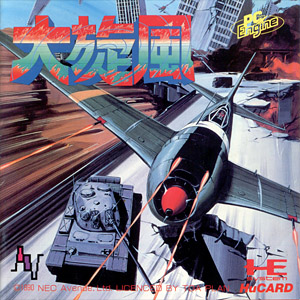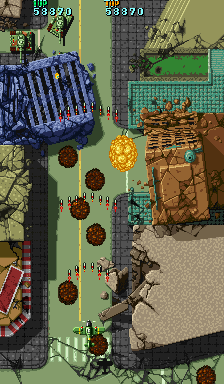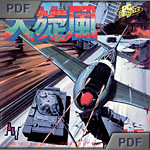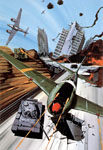|

|

|
|
大旋風
1990 NEC Avenue, Ltd.
Licensed by Toaplan Co.,Ltd.
Release: 1990-12-14 (¥7200)
HuCard (4 Mbits) NAPH-1014
Shooter / Vertical
|
Daisenpū is a vertical shooter by Nec Interchannel and conversion of
the arcade game of the same name (also known as Twin Hawk) originally released by
Toaplan in 1989. In the year 193X, country R is overwhelmed by hostile enemy
forces and the small oasis town 'S' is the main target of the attack. A handful of
survivors escape to the jungle and start working on a counter attack - but they are soon
discovered and are now running out of time, and they must launch the Daisenpū
squadron before it is fully operational. The player takes control of a fighter plane and
must fly deep into enemy territory, attack ground targets such as tanks, turrets and
warships (the game curiously doesn't feature any flying enemies and no obstacles to fly
into, beside enemy bullets). The plane starts equipped with a limited double-shot machine
gun that can be slowly upgraded throughout the game by collecting power-pods left behind
by small trucks. But the originality of Daisenpū lies elsewhere - the player can
call a small squadron of six planes and have them fly in formation, shooting anything in
sight and crashing into an enemy unit when defeated. The squadron can also commit a
Kamikaze attack at anytime and destroy ground units, or combine to release a
devastative bomb-attack. Finally, Daisenpū offers an unusual feature - levels
do not pause between them and reveal instead a continuous flow of undisturbed shooting
action.
|
 The arcade game Daisenpū (picture on the left, also known as
Twin Hawk in the rest of the world) was originally
released in 1989 and followed in the steps of Hi Shō Zame (aka Flying Shark)
released in 1987. The game featured a long vertically oriented screen and an option for a two-player
mode (although each player had to take turns and couldn't play simultaneously). In the Toaplan
tradition, Daisenpū was a difficult arcade game and was most certainly designed to gobble-up
players' coins by whatever means necessary. The game, like its predecessors, was ported to various
home consoles at the time such as the PC Engine (Hucard, version tested here and a
CDRom version called Daisenpū Custom in 1991) and Sega Megadrive (1990). As
a side note, the PC Engine version tested here loops at the end of the game which was
also the case in the original arcade - but it is hard to say if both version loop in-definitively,
or eventually stop. Additionally, the PC Engine CDRom version released in 1991 is curiously
not as good as the cartridge version tested here, and the developers had to surprisingly make
numerous compromises and cut back on some of the HuCard features (see the CDRom review
for more information).
The arcade game Daisenpū (picture on the left, also known as
Twin Hawk in the rest of the world) was originally
released in 1989 and followed in the steps of Hi Shō Zame (aka Flying Shark)
released in 1987. The game featured a long vertically oriented screen and an option for a two-player
mode (although each player had to take turns and couldn't play simultaneously). In the Toaplan
tradition, Daisenpū was a difficult arcade game and was most certainly designed to gobble-up
players' coins by whatever means necessary. The game, like its predecessors, was ported to various
home consoles at the time such as the PC Engine (Hucard, version tested here and a
CDRom version called Daisenpū Custom in 1991) and Sega Megadrive (1990). As
a side note, the PC Engine version tested here loops at the end of the game which was
also the case in the original arcade - but it is hard to say if both version loop in-definitively,
or eventually stop. Additionally, the PC Engine CDRom version released in 1991 is curiously
not as good as the cartridge version tested here, and the developers had to surprisingly make
numerous compromises and cut back on some of the HuCard features (see the CDRom review
for more information).
|
O
M
A
K
E
|
|


|
|
|
Click on picture to enlarge |
|
|
|
LK

|
|
Add your Pov here !
|
P
O
V
s
|
|
Daisenpū has a couple of nice features such as the 'endless' level
structure, which can be a little disturbing at first - it is amazing how our brain
works and needs a psychological break after a boss battle.
I believe that these pauses work in much the same way
commercial breaks in television programs do and I wonder if we would ever take bathroom breaks
without them. Anyway, back to Daisenpū. Despite this, the game is overall really
disappointing - controls are slow and the gameplay is equally bland and sluggish, all of it accompanied by a
relatively boring and repetitive music...
well, there's not much going on, really. Graphics, although correct, are also not as detailed as
the arcade which is a real shame. Enemies and bosses are well drawn but they don't save the rest
of the game from tedium repetition and a lack of ambition... All in all, there is nothing
terribly bad about Daisenpū and this conversion kind of works if
you enjoy the original arcade game... but it could have been a much better game.
|
|
|
|